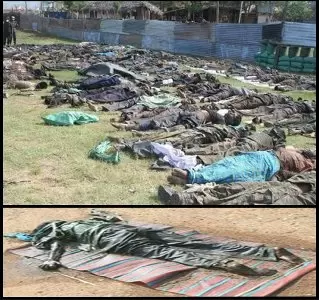Ban Ki Moon’s double standard in dealing with Sri Lanka on war crimes

20-May-2011
Vol 2 | Issue 20
The United Nations Secretary General Ban Ki Moon was reluctant at first to appoint a panel to go into the issue of war crimes committed by Sri Lanka in the last phase of its war against the LTTE. Then when the three member expert panel’s report was ready on March 31, 2011, he did not make it public until April 18. Here, one is made to presume that Vijay Nambiar, the Chief of Staff of Ban was behind the move to see that the report was released after the Assembly elections in the Indian State of Tamil Nadu were completed (on April 13) to save the Congress and DMK from any embarrassment.
The panel was set up by Moon in June 2010 only after the Permanent People’s Tribunal declared Sri Lanka guilty of War Crimes, Crimes against Humanity and Crimes against peace at Dublin in January 2010 and the International Crisis Group released its report in March 2010.
 |
|
War crime?: Bodies of Tamils killed in an alleged chemical attack by Lankan forces (Photo courtesy: Save Tamils Movement)
|
When Sri Lanka refused permission for the UN panel to enter the nation, Moon and the international community kept mum. In fact Moon kept quite in a lot of other issues as well. The UN report very clearly states that time and again their offices, hubs and even relief distribution centers were relentlessly attacked, but the UN had not done anything to warn the Sri Lankan forces who deliberately bombed its establishments.
The UN did not exert international pressure on the Sri Lankan government to allow INGOs and UN agencies to continue humanitarian operations in the war zones. If that had been ensured, it would have averted the human catastrophe. A point to be remembered here is that the media is censured even today from covering events in the Vanni.
In September 2008, the UNWFP (United Nations World Food Programme) estimated the presence of 420,000 civilians in the war zone, but the government figures said there were only 100,000. As a result the government compelled the UNWFP to carry food only for one fourth of the civilians. On May 13, the UN estimate was 100,000 civilians in the war zone, but the government estimate was 10,000. At the end of the war only 282,000 civilians entered the barbed wire Manik farm camps. The UN and the GoSL need to answer what happened to the rest of the population?
Why does Ban Ki Moon consistently say that he cannot compel Sri Lanka to implement the recommendations of the UN panel? The panel’s primary objective was not to highlight the failures of the UN system but to investigate the wrong doings of the Sri Lankan state against the Tamils.
Though the war ended two years ago, the draconian Prevention of Terrorism Act and the Emergency Regulation Act is still in force in Sri Lanka. The Tamil population there is being systematically eliminated. Is the Sri Lankan Tamil issue a problem of the Tamils alone or is it a problem of humanity? Ban Ki Moon has to do a lot of soul searching.
(The author holds a Doctorate of Philosophy on ‘Internal Displacement and Human Rights situation in Northern Sri Lanka from Bangalore University. He was one of the four public speakers at the Permanent People’s Tribunal on War Crimes against Sri Lanka)
Also Read: Though a Bihari, Ram Vilas Paswan feels for Tamils in Sri Lanka
















